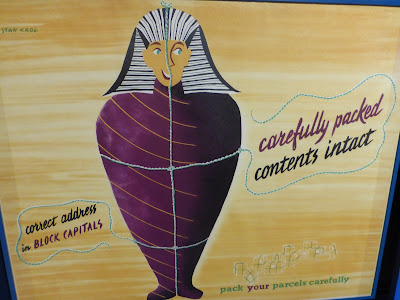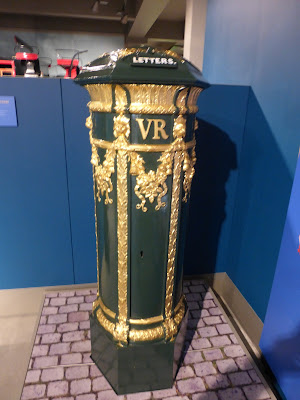The Postal Museum has finally reopened in new premises. Ever since visiting Debden on the Central line where the Royal Mail storage depot is situated, I have awaited tho opening of this new museum with great excitement. Not because of the fine postal memorabilia but because of the mail train!
This is an example of a frock coat worn by a mail guard. The guards carried guns as well as a post horn. The mail coach had priority over all other road users. The post horn's blast blast warned others to move out of the way.



When Edward VIII came to the throne in 1936, the Post Office produced stamps showing his portrait and over 160 new pillar boxes. But Edward VIII reigned for less than a year before he abdicated and George VI became king. The Post Office had to produce new stamps again and when the Edward VIII pillar boxes were repaired the initials were changed to GVI. So these pillar boxes are very rare.

The museum isn't just about the post but other forms of communication such as the phone.
Remember the old A and B telephones?
 |
| 1941 |
 |
| 1954 |
 |
| 1953 |
 |
| 1939 |
 |
| 1937 Outposts of the Empire, Barbados |
 |
| 1962 |
Battle of Britain and Churchill stamps.
 This is a plaster cast of the Queen wearing the diadem rather than a tiara (1966). This is used to finalise the design of the Queen's head on stamps.
This is a plaster cast of the Queen wearing the diadem rather than a tiara (1966). This is used to finalise the design of the Queen's head on stamps.
In 1911 an electric driverless railway was suggested and an act of Parliament was passed in 1913. The new railway would consist of six and a half miles of tunnels linking the East and West ends of London with 8 stations including Paddington, Mount Pleasant and Liverpool Street. Due to the war the railway didn't open until 1927. The tunnels were used in the first world war to store and protect art treasures from the National Gallery and the Tate Gallery. In the 1990s more than six million bags of mail were carried below ground each year. That's four million letters a day.
These trains were built for mail bags not people.

Here's an old photo of the mail bags being loaded onto the train.

It was very cramped inside and we were asked not to touch the sides as the train would automatically stop. Easier said than done.
The trains have been updated with seats etc but they are still the same size as the Mail Rail.
I really enjoyed my visit to the Museum and a ride on the train.









































